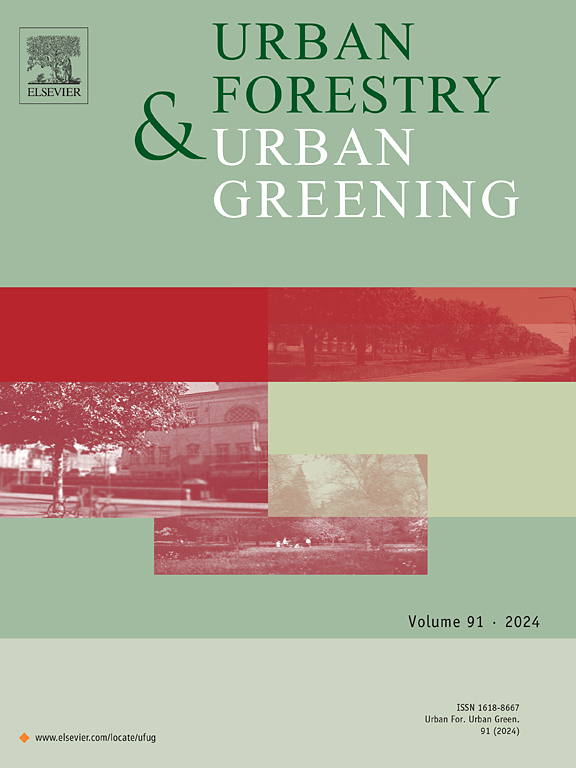Is compensation a myth? Modelling the use of public and private urban green spaces in relation to the geographical context
IF 6
2区 环境科学与生态学
Q1 ENVIRONMENTAL STUDIES
引用次数: 0
Abstract
The compensation hypothesis postulates that the absence of green spaces in residential areas leads to a greater use of public green spaces and nature in general. This paper tests this hypothesis by focusing on the use of public and private urban green spaces. A holistic approach is adopted that considers the complexity of residential context and the use of urban, peripheral and private green spaces. A survey was conducted in two medium-sized French cities (Dijon and Besançon) to identify how their green spaces were used and perceived. The residential context was described through multiple spatial and environmental metrics (physical and visual access to nature, noise level, private green space area) that were GIS-referenced to postal addresses. On the basis of that data, the compensation hypothesis was explored using a PLS path model. The results show the absence of compensatory behaviour when considering just the overall relationships between the use of different types of green spaces. However, conditional compensatory behaviours can be detected when allowance is made for other variables (physical and visual accessibility to nature, type of housing, dwelling floor area, noise level). These results remain dependent on the geographical context of the city, with a higher compensation effect where natural areas are less accessible.
补偿是个神话吗?建立与地理环境相关的城市公共绿地和私人绿地使用模型
补偿假说认为,居住区缺少绿地会导致人们更多地使用公共绿地和大自然。本文通过关注城市公共绿地和私人绿地的使用来验证这一假设。本文采用了一种综合方法,考虑了居住环境的复杂性以及城市、周边和私人绿地的使用情况。本文在法国的两个中等城市(第戎和贝桑松)进行了一项调查,以确定人们是如何使用和看待绿地的。通过地理信息系统(GIS)中与邮政地址相关的多个空间和环境指标(接触自然的物理和视觉条件、噪音水平、私人绿地面积),对居住环境进行了描述。在这些数据的基础上,使用 PLS 路径模型对补偿假设进行了探讨。结果表明,如果只考虑不同类型绿地使用之间的总体关系,则不存在补偿行为。然而,如果考虑到其他变量(自然的物理和视觉可达性、住房类型、住宅建筑面积、噪音水平),则可以发现有条件的补偿行为。这些结果仍然取决于城市的地理环境,在自然区域交通不便的地方,补偿效应更高。
本文章由计算机程序翻译,如有差异,请以英文原文为准。
求助全文
约1分钟内获得全文
求助全文
来源期刊

Urban Forestry & Urban Greening
FORESTRY-
CiteScore
11.70
自引率
12.50%
发文量
289
审稿时长
70 days
期刊介绍:
Urban Forestry and Urban Greening is a refereed, international journal aimed at presenting high-quality research with urban and peri-urban woody and non-woody vegetation and its use, planning, design, establishment and management as its main topics. Urban Forestry and Urban Greening concentrates on all tree-dominated (as joint together in the urban forest) as well as other green resources in and around urban areas, such as woodlands, public and private urban parks and gardens, urban nature areas, street tree and square plantations, botanical gardens and cemeteries.
The journal welcomes basic and applied research papers, as well as review papers and short communications. Contributions should focus on one or more of the following aspects:
-Form and functions of urban forests and other vegetation, including aspects of urban ecology.
-Policy-making, planning and design related to urban forests and other vegetation.
-Selection and establishment of tree resources and other vegetation for urban environments.
-Management of urban forests and other vegetation.
Original contributions of a high academic standard are invited from a wide range of disciplines and fields, including forestry, biology, horticulture, arboriculture, landscape ecology, pathology, soil science, hydrology, landscape architecture, landscape planning, urban planning and design, economics, sociology, environmental psychology, public health, and education.
 求助内容:
求助内容: 应助结果提醒方式:
应助结果提醒方式:


